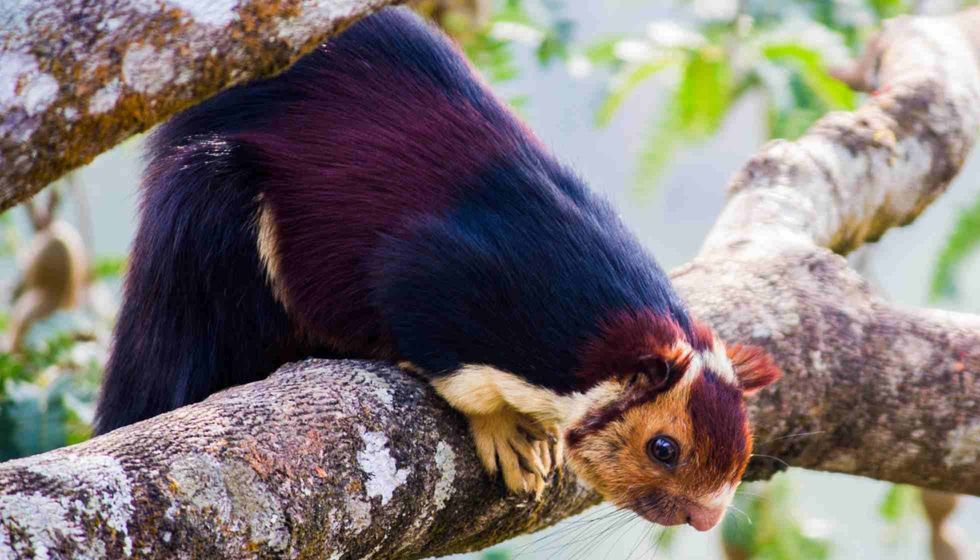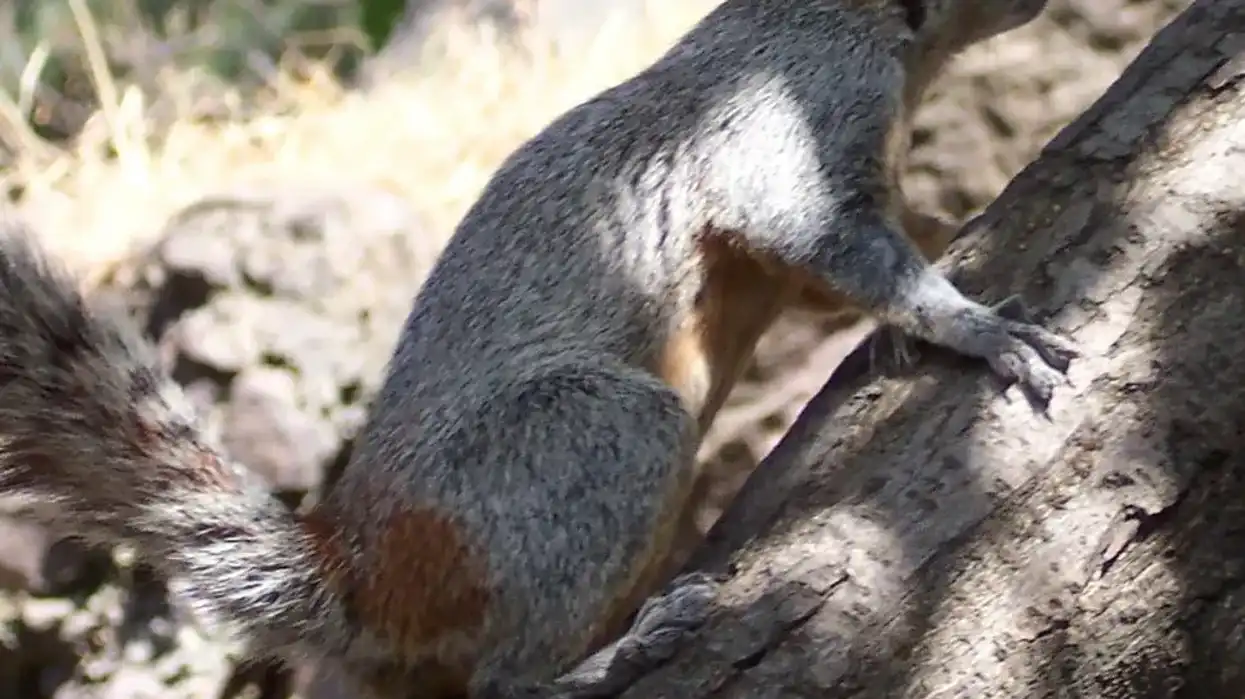Also known as the Malabar giant squirrel, the Indian giant squirrel (Ratufa indica) is native to India. There are four subspecies of these rodents namely Ratufa indica indica, Ratufa indica dealbata, Ratufa indica maxima, and Ratufa indica centralis.
Although they are considered pests, they help in maintaining the ecological balance of their habitat by dispersing seeds throughout the territory via their feces.
Do you know that the length and weight of a squirrel's tail are almost equivalent to that of its body? Their tail plays a vital role in maintaining the balance of their body.
Indian giant squirrels are adept at hiding from predators by implementing the camouflaging technique. When predators are nearby they just freeze.
The brown color of their body helps them to hide in any tree. In his book, 'Squirrels Of The World', John Koprowski talks of how the purple shade of these giant squirrels acts as a camouflage that helps these animals to protect themselves from predators. Read on to know more about the Indian giant squirrel.
If you enjoyed these fun-filled facts about the Indian giant squirrel then you can also take a look at some mind-boggling facts about the flying squirrel and the fox squirrel.
Indian Giant Squirrel Interesting Facts
What type of animal is an Indian giant squirrel?
An Indian giant squirrel is a tree squirrel, often classified as a rodent.
What class of animal does an Indian giant squirrel belong to?
An Indian giant squirrel belongs to the class Mammalia.
How many Indian giant squirrels are there in the world?
The accurate number of these squirrels cannot be ascertained without proper data. However, the IUCN has stated that their population is on a steady decline.
If newspaper reports are taken into account it has been reported that a survey was conducted by the forest department in areas like Ambegaon, Pune, and Thane according to which the total nest count was about 12,870 with around 2,145 Malabar giant squirrels inhabiting the area.
This indicates that conservation initiatives are being taken by the concerned departments to preserve the Ratufa indica.
Where does an Indian giant squirrel live?
Indian giant squirrels can commonly be found in several regions of the Indian subcontinent. They can be mostly located in the southern and western parts of India like Maharashtra, Western Ghats, southern Gujarat, Kerala, Tamil Nadu, Pune, and Madhya Pradesh. They can also be found in several sanctuaries and national parks, like the Satpura National Park.
What is an Indian giant squirrel's habitat?
Forests are the primary dwelling places of the Malabar giant squirrel. Their habitat includes tropical, evergreen, and deciduous forests, as well as woodlands and shrublands. The habitat of these giant squirrels is also in sanctuaries and national parks across the country.
Who do Indian giant squirrels live with?
Indian giant squirrels are normally solitary creatures as they love to live on their own, but they are also known to live with their counterparts from the opposite sex during the breeding season.
How long does an Indian giant squirrel live?
These solitary squirrels can live up to 20 years in captivity. They might even live more than 20 years in the wild but due to a lack of data, no conclusive statement can be made.
How do they reproduce?
Little information is available about the breeding habits of the Indian giant squirrels. The species is known to engage in breeding throughout the year. However, the time between October and January is the ideal breeding season.
The males are believed to compete for pairing up with females. The females search for trees in which to build their nests throughout the territory.
They have a gestation period that ranges from an average length of 28 to 35 days. After the gestation period, they give birth to one or two pups (with a maximum number of three). The young ones take some time to be capable enough to search for their food.
What is their conservation status?
As per the computations of the International Union for Conservation of Nature (IUCN) Red List, the preservation requirement of the Indian giant squirrels is of Least Concern. However, according to reports, the current population trend shows a steady decline.
Indian Giant Squirrel Fun Facts
What do Indian giant squirrels look like?

The Malabar giant squirrels possess a large body. The primary color varies among dark shades of red, brown, purple, black, and maroon which dominates their entire look from head to tail. They have a pink nose, light or dark brown eyes, creamy underside, and a long bushy tail. Both males and females have a similar appearance.
How cute are they?
The Malabar giant squirrel is adorable when it comes to its appearance. Despite not having a colorful fur coat, the unique dark shades of their body give them a vibrant look that no animal lover can resist.
How do they communicate?
These rodents use their tail for signaling purposes. When they sense danger looming in the vicinity, mainly predators, they twitch their tails to warn the others. Vocalizations include mating calls, territorial calls, and alarm calls.
How big is an Indian giant squirrel?
The full body length of the species measuring from head to tail extends from 10-18 in (25-45 cm). When compared with a normal gray squirrel, Indian giant squirrels are almost three times bigger.
How fast can an Indian giant squirrel run?
The Malabar giant squirrel can gain a speed of up to 20 mph (32 kph). These creatures are full of sprite and agility and can cover long distances by jumping, 6m long or more, and moving about from tree to tree owing to their strong hind legs.
How much does an Indian giant squirrel weigh?
Irrespective of the sex of the squirrel, average Indian giant squirrels weigh around 3-4 lb (1.5-2 kg).
What are the male and female names of the species?
The males and females of the Indian giant squirrel are referred to as bucks and does respectively.
What would you call a baby Indian giant squirrel?
The baby of an Indian giant squirrel is commonly called a kitten or pup.
What do they eat?
These animals have an omnivorous diet. This means that they enjoy a varied diet comprising flowers, nuts, fruits, bird eggs, insects, and tree bark.
Are they dangerous?
These creatures might not be extremely approachable or friendly, particularly the wild ones, but they are not known to have an aggressive nature. Quite the contrary, these solitary squirrels remember people, especially when they protect them in the face of danger.
Would they make a good pet?
Generally, these tree-dwelling giant squirrels are not kept as pets. There are instances where they have been reared in captivity.
They might appear to have friendly habits and drop in for feeding, but they are rodents with sharp claws. Scratches and bites from this species can expose one to deadly diseases. Moreover, squirrels should be allowed to dwell freely in their natural habitat in the wild.
Did you know...
A group of squirrels is collectively called a scurry, colony, or dray.
These squirrels are locally known as 'shekrus'.
Squirrels have a commendable memory! Once you offer them their favorite snacks like seeds, fruits, or bird eggs, they will greet you for days to come for some more food.
Is the Indian giant squirrel endangered?
As per the observations of the IUCN, these animals are not vulnerable or endangered although their population does exhibit a significant decline. The reason for the decrease in population can be attributed to climate change and the destruction of their habitat.
Human interference which includes deforestation, mining, and construction projects is one of the major threats. Nevertheless, initiatives are being taken by the forest departments to preserve these little animals from the onslaught of extinction.
What are the characteristics of the Indian giant squirrel?
Native to peninsular India, the Indian giant squirrel can be differentiated from the other species in several aspects. The defining characteristics of these animals are that they are arboreal, diurnal, and sedentary.
Unlike the common palm tree squirrels, this species does not have stripes on its back. According to Hindu mythology, the striped back is a symbol of Lord Rama's blessings in the form of a caress.
These squirrels belong to the group of diurnal creatures that search for food or engage in other activities during the morning or evening.
Unlike the ground squirrels that move about at ground level, they prefer jumping among trees. They are also one of the only squirrels to store their food in trees rather than underground.
Here at Kidadl, we have carefully created lots of interesting family-friendly animal facts for everyone to discover! Learn more about some other mammals including deer and squirrels.
You can even occupy yourself at home by drawing one of our Indian giant squirrels coloring pages.










